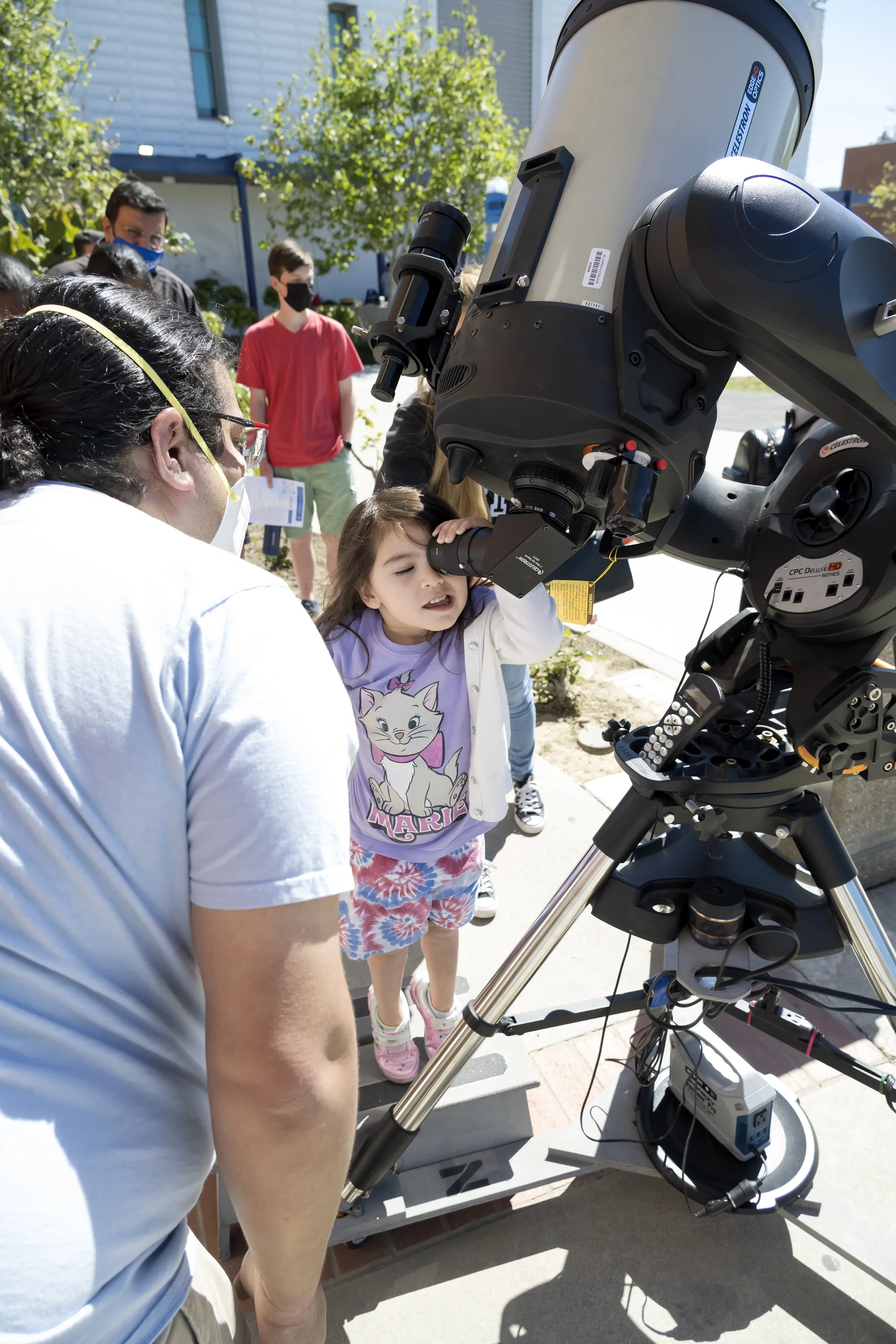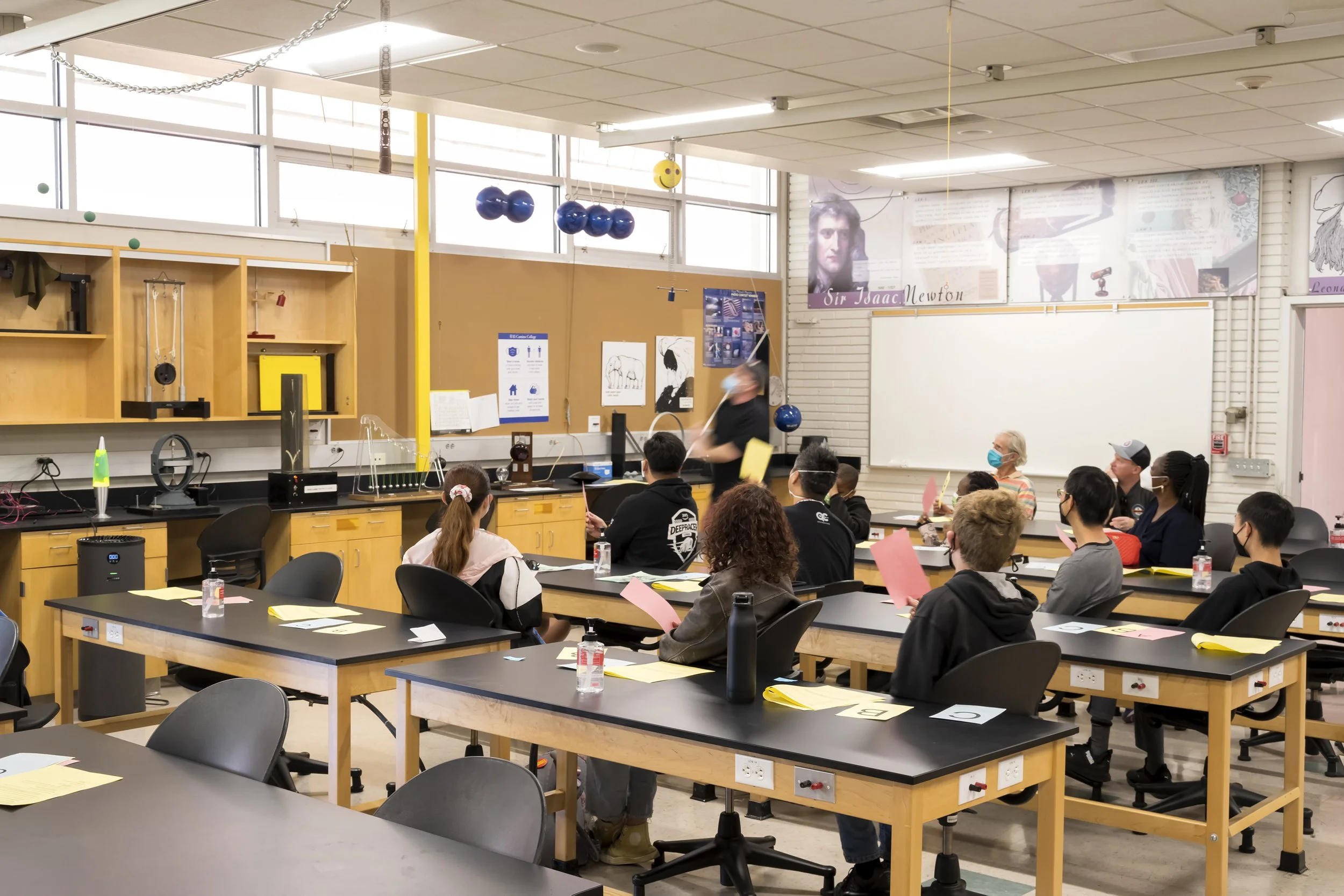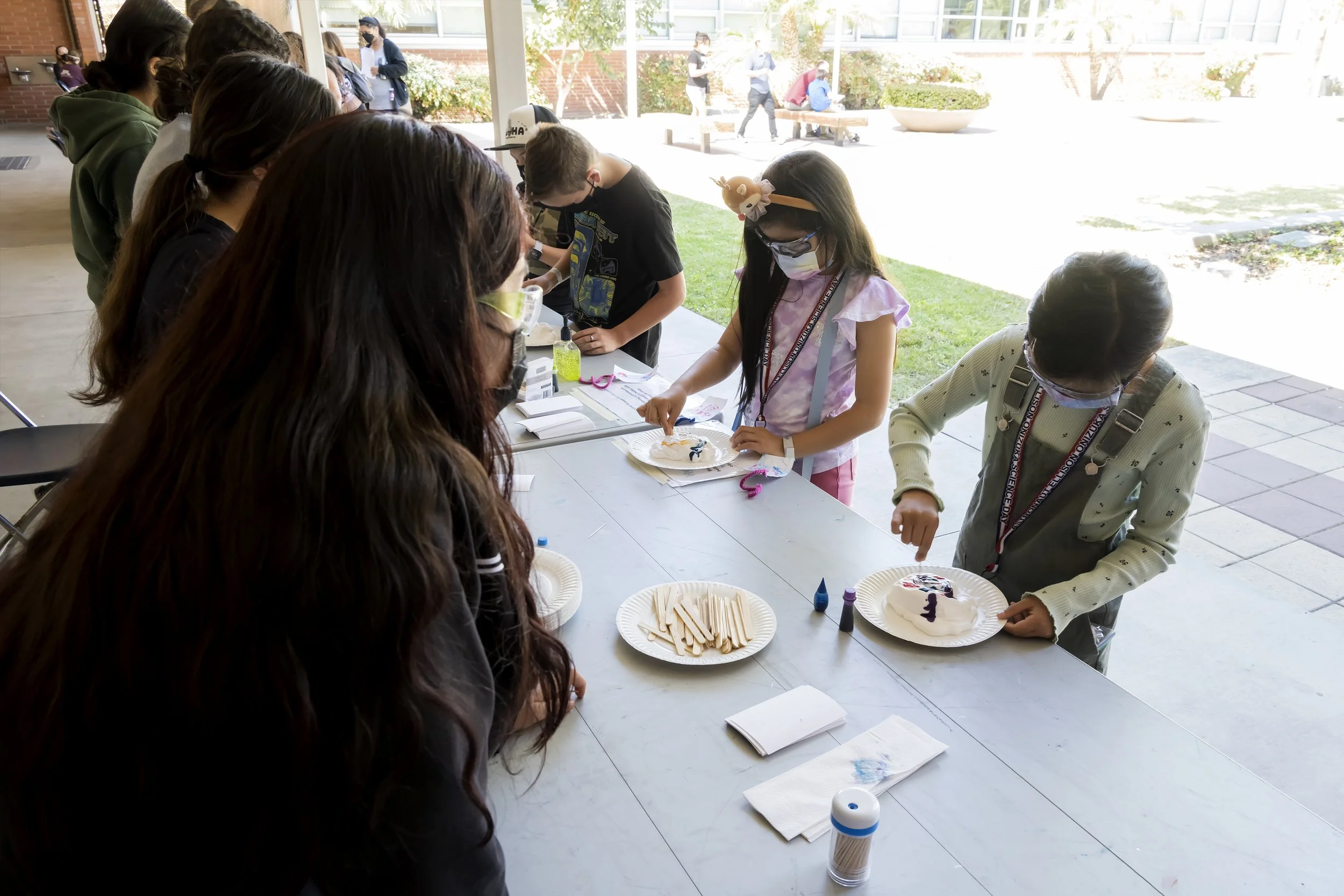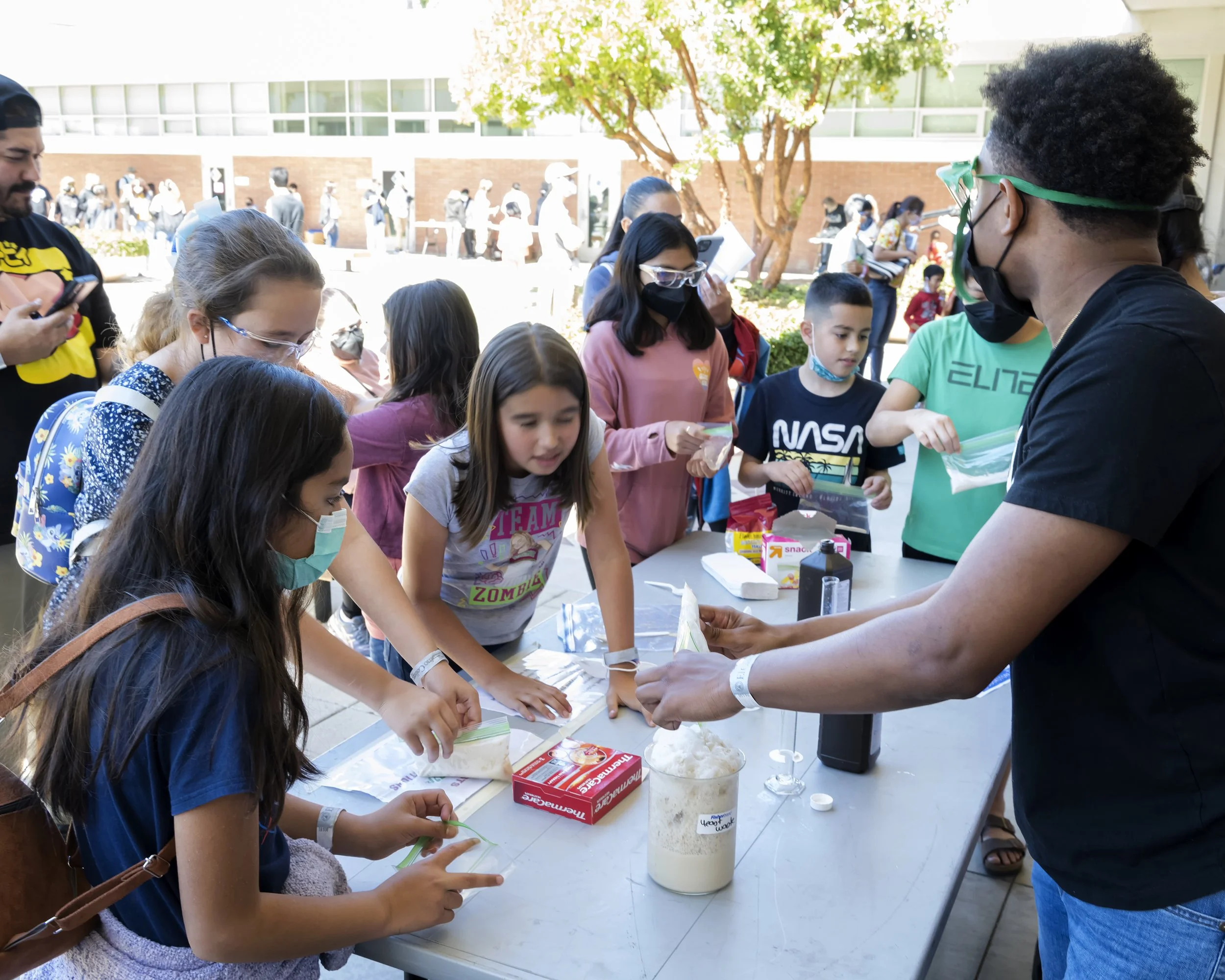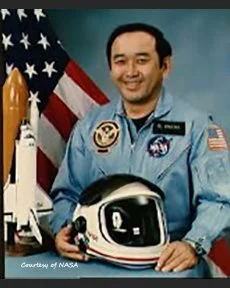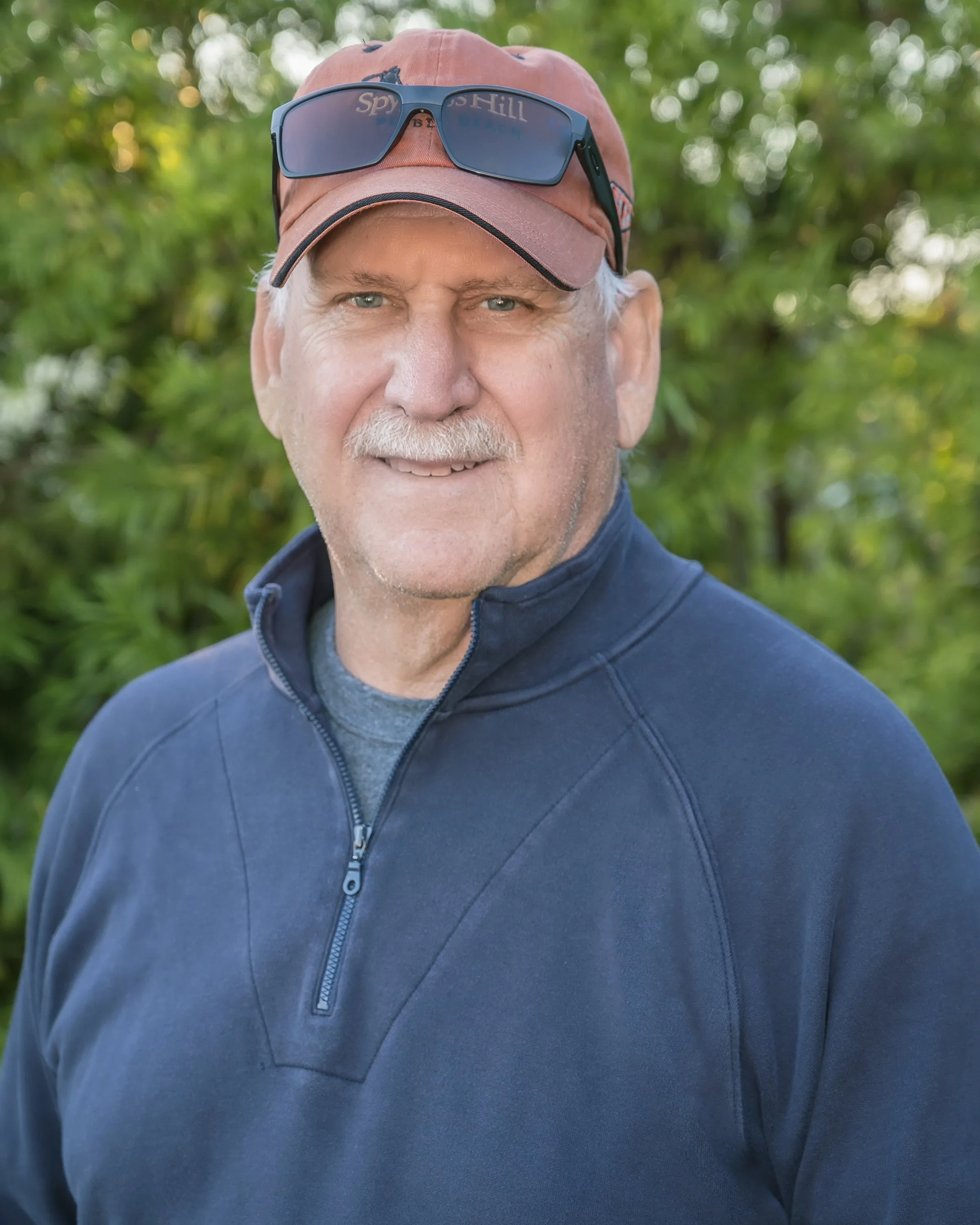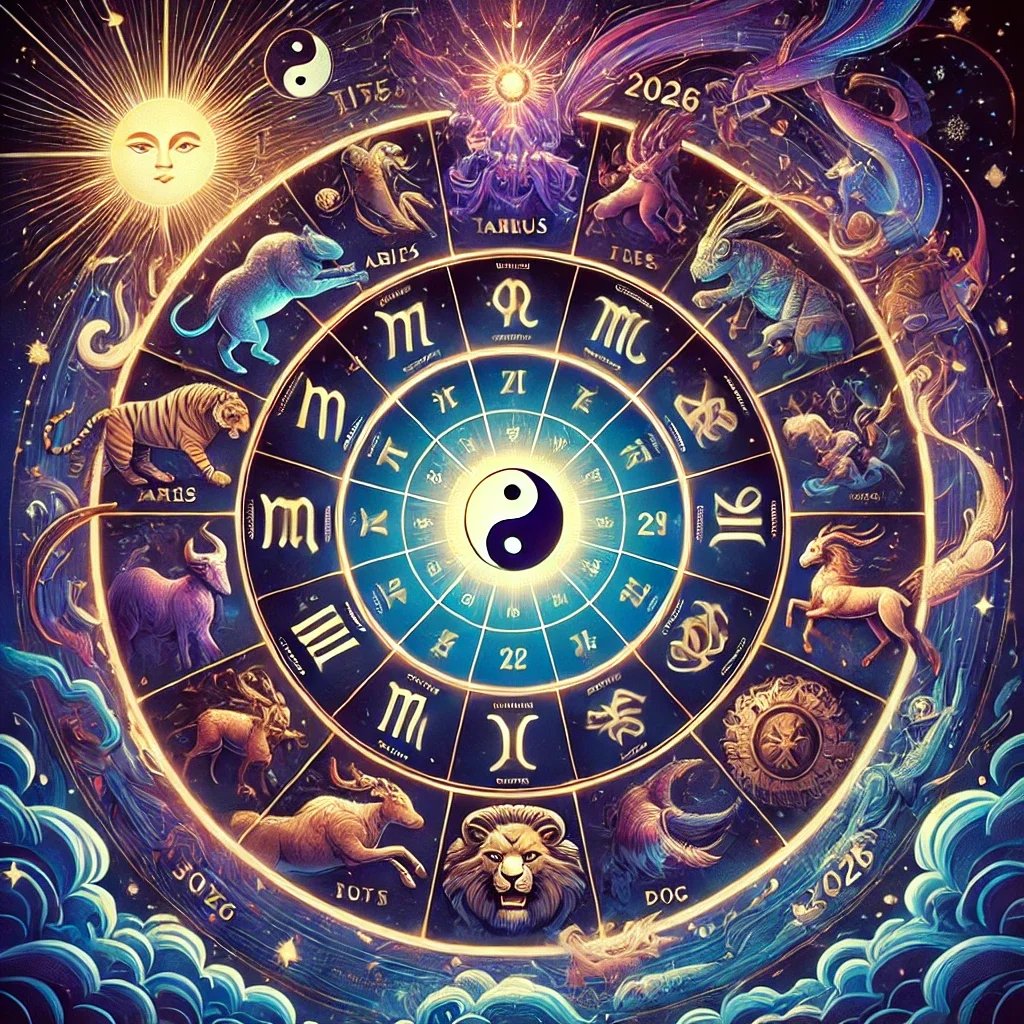Their Courage and Ambition Continues to Inspire Us All - The Ellison Onizuka Memorial Committee Uses the Challenger Space Shuttle Tragedy to Inspire Young Learners By Steve Tabor
The Ellison Onizuka Memorial Committee along with event sponsor, American Honda Motor Company, presented the 35th Annual Onizuka Space Science Day (OSSD) at El Camino College. Following the tragic loss of the seven crew members of the Challenger Space Shuttle disaster, the desire not only to continue to honor the memory of Ellison and his fellow six crew members, but look to their sacrifice to motivate and inspire children and to follow their imaginations and turn their visions into reality.
Left to right: Dr. Michael Barrett, Dr. Brenda Thames, President of El Camino College, and Dr. Tim Stowe
Onizuka’s brother, Claude, recalls that growing up on the Kona side of Hawaii Island, Ellison and he were best friends. Claude recalls that Ellison was fascinated watching the Mercury capsules splash down at the conclusion of their mission, but Ellison never spoke of a desire to visit space. Claude remembers that he was always amazed how Ellison did not undertake any activity without giving his full and complete effort. Claude points out that Ellison became set on achieving his Eagle Scout status and accomplished this goal in four years.
When Ellison entered Colorado University in the City of Boulder, he joined the Air Force ROTC program. Claude remembers Ellison loved flying and would do anything he could to pursue that dream. The space program seemed like a natural next step. Claude recalls a day in 1978 when he was listening to his radio and heard the news that Ellison had been accepted to the astronaut program. Anxious to share the news, Claude tried contacting their mother, but her phone was already too busy for him to get through to talk with her.
As one can imagine, Claude reflects on that tragic day in January with a sense sadness and loss. After a slight pause, he insightfully remarks, “Ellison ended up doing what he wanted to do! And though this was a tragic event, a lot of good things came out of it.”
Almost immediately following Ellison’s and the other Challenger astronaut’s deaths, a group of friends and fellow Hongwanji Buddhist Temple members felt a strong desire to perpetrate his memory and created the Astronaut Ellison S. Onizuka Memorial Committee (AESOMC).
The Committee took little time to plan and initiate the first annual OSSD on the University of Southern California campus. According to Claude, Ellison would have fully supported the event. Claude shares, “When Ellison would return home for vacation, I would ask if he wanted to play golf or get together with friends and talk story. Instead, Ellison would tell me he’d rather spend time sharing his experiences with school kids and using his experiences to inspire their dreams.”
According to Ellison, “Your vision is not limited by what your eyes can see, but by what your mind can imagine. Many of the things that you take for granted were considered unrealistic dreams by previous generations. If you accept these past accomplishments as commonplace, then think of the new horizons that you can explore.”
The Committee focuses on including middle school and upper elementary school students throughout Southern California in the day’s activities. Arguably, the most popular event of the day is the opportunity to hear firsthand from a NASA astronaut about their space exploration experiences. However, the message extends far beyond the presentation and challenges students to understand that they can achieve such accomplishments without being the smartest in their class, if you dedicated your desire and energies to fuel your passion to achieve your dream.
This year, space veteran Dr. Michael Barrett, spoke to the audience about his career pathway and his experiences on the International Space Station (ISS). Barrett shares that he did not start out wanting to fly in space, having grown up on a cattle and sheep ranch in Southwest Washington. At the time he attended the University of Washington (UW) he was not considering a career in space as he pursued a bachelor’s degree in marine zoology. Following that his curiosity led him to pursue a doctorate in internal medicine. Eventually, his academic journey took Barrett to the Wright Patterson Air Force Base to study Aerospace Medicine. Barrett shares, “I was not very fond of my early school years. But, what I found was that the further I went along the less burdensome school becomes and, it evolves into something that is fun and more meaningful.”
Barrett stresses, “You do not have to be the top of your class to succeed. However, it is important that you develop your dream, and you must be willing to put in all of your energies into learning and improving your knowledge and skills to achieve that dream. Then, as you follow your dream, you will be surprised about how you will find many interesting opportunities you’re able to pursue.”
One of the surprises for Barrett was becoming a graduate of NASA’s Astronaut training in 2000. Barnett admits it was not always on his career pathway, but through his schooling it became an opportunity he wanted to pursue. He admits there were other more capable and smarter candidates, but I focused my energies on achieving this goal and worked hard to accomplish it.
Barrett stresses that there are many non-academic skills, such as personal and interpersonal skills, that space exploration shares with other professions that are critical to making your mission and you a success. Teamwork is critical to the success of any mission. A successful space mission not only depends on the space crew, but on the work and contributions of hundreds of engineers and others that never leave the ground, yet who make valuable contributions before, during and after the mission. It is important that you realize that others depend on you to fulfill your responsibilities when you are called upon. As a result, it is important that you take care of yourself and be fully prepared to fulfill those responsibilities when the time comes for you to do your part.
Following Barrett’s presentation, students along with their parents had the opportunity to participate in several Science, Technology, Engineering and Mathematics (STEM) activities. Among the most popular activities were the Egg Drop and Paper Airplane construction. Both activities were conducted under similar conditions the astronauts on Apollo 13 faced in successfully bringing their crippled space craft back to earth with a limited set of materials at hand.
The Egg Drop contestants were tasked with constructing a container that would allow their raw egg to remain intact after it was dropped from a two-story building. Although, adults standing on the perimeter of room were anxious to take part in the activity, they were instructed to not to interfere with the young scientists as they constructed their capsule. Later in the day, the students would learn if their efforts were successful or not.
Students participating the Paper Airplane construction were tasked with creating an airplane that would compete with other airplanes constructed by their peers. In the end, each airplane would be judged on the final distance flown. For inspiration, the students had several examples to follow, but they were allowed to develop and build their own design.
Other sessions included the basic principles of physics and using those principles to predict and measure outcomes. Additionally, students used simple fluids and objects found throughout their homes to conduct a variety of experiments.
Dr. Tim Stowe, President of the AESOMC and Superintendent of the Torrance Unified School District, summarizes, ”Today’s goal is inspiring students to realize that they can pursue and achieve their dream with hard work and commitment. Don’t ever think it is too late to make a change and there are endless possibilities to pursue!”
Epilogue
Although the event features Ellison Onizuka, AESOMC committee members want all of us to remember “Onizuka Space Science Day is dedicated to the memory of the seven Challenger astronauts who lost their lives in the pursuit of their dreams. Their courage and ambition continues to inspire all.”
Godspeed to the flight crew of Challenger Mission, STS-51-L, Francis Scobee, Commander, Michael Smith, Pilot, Ronald McNair, Mission Specialist, Ellison Onizuka, Mission Specialist, Judith Resnik, Mission Specialist, Gregory Jarvis, Payload Specialist, and Christa McAuliffe, Payload Specialist and Teacher in Space.
Steve Tabor Bio
This South Bay native’s photographic journey began after receiving his first 35 mm film camera upon earning his Bachelor of Arts degree. Steve began with photographing coastal landscapes and marine life. As a classroom teacher he used photography to share the world and his experiences with his students. Steve has expanded his photographic talents to include portraits and group photography, special event photography as well as live performance and athletics. Steve serves as a volunteer ranger for the Catalina Island Conservancy and uses this opportunity to document the flora and fauna of the island’s interior as well as photograph special events and activities.
Watch for Steve Tabor Images on the worldwide web.
Related Articles





